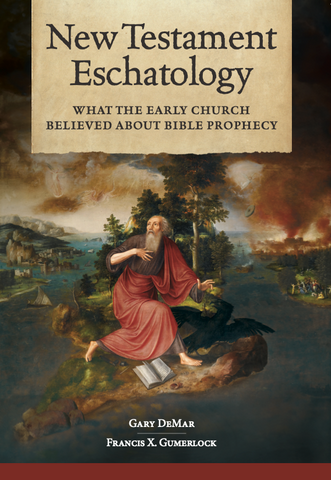The Nicene Creed and its anonymous cousin, the Apostles’ Creed, have been standards of orthodoxy for around 1700 years. A charge made against Christians who ask questions about the creeds is that the creeds use “man’s language,” thus invalidating their authority. This is a harsh and mistaken claim since most of the statements in both creeds are taken directly from verses in the Bible, thus, they are God’s language for the most part: From God as the Creator of heaven and earth (Gen. 1:1) and one Lord Jesus Christ (1 Cor. 8:6) to Jesus being born of the Virgin Mary (Luke 1:27), having suffered under Pontius Pilate (John 18:24-40), and that He will come again, with glory, to judge both the living and the dead (Matt. 16:27-28; 25:31).
These creedal statements are historical snapshots of events from the Apostolic era using biblical language. What they copied from the Bible must be interpreted by the Bible (Acts 17:11). All creeds and Christians who recite them are bound by the text of Scripture. If we cannot agree on this basic point, then we cannot agree on much else. Yes, the creeds have consistency and history on their side. This is not in dispute. I believe Jesus came to judge the living and the dead, not because the creeds say it, but because the Bible says it. The creeds and the Bible should not be in conflict. The Bible is to govern the meaning of every word of the creeds. Jesus coming to judge the living and the dead was future for that Apostolic generation as the Bible makes clear. Like dispensationalists who appeal to the OT to support their views by skipping over the fulfillment of prophetic passages either in the return of Israel from the exile and/or the New Covenant,[1] those reading the creeds skip over the coming of Jesus that took place before “this [their] generation” passed away (Matt. 24:34). I cover this topic in chapter 8 of my book Prophecy Wars: The Biblical Battle Over the End Times.

Prophecy Wars: The Battle Over the End Times
There is a long history of skeptics turning to Bible prophecy to claim that Jesus was wrong about the timing of His coming at “the end of the age” (Matt. 24:3) and the signs associated with it. Noted atheist Bertrand Russell (1872-1970) is one of them and Bart Ehrman is a modern example. It’s obvious that neither Russell or Ehrman are aware of or are ignoring the mountain of scholarship that was available to them that showed that the prophecy given by Jesus was fulfilled in great detail just as He said it would be before the generation of His day passed away.
Buy NowHere are the phrases from the Apostles’ Creed and Nicene Creed about the coming of Jesus:
• He ascended to heaven and is seated at the right hand of God the Father almighty. From there he will come to judge the living and the dead (AC).
• He ascended to heaven and is seated at the right hand of the Father.[2] He will come again with glory to judge the living and the dead (NC).
What does the NT say about when Jesus would come to judge the living and the dead? Jesus’ ascension and session [3] are historical facts as are the other creedal statements. He came “again with glory to judge the living and the dead.” If the “again” refers to Jesus’ judgment-coming that took place before that first-century generation passed away. Both creeds, and the later Athanasian Creed (451), state the biblical fact of Jesus’ coming in the same way the NT states that Jesus was “born of the Virgin Mary.” They are statements of historical facts. If the creeds are understood in terms of what the NT states as fact, then the creeds got it right like they got it right that Jesus suffered under Pontius Pilate!
Unfortunately, we read the creedal statements about Jesus’ coming and argue that they refer to an additional coming after the coming Jesus said would happen in the generation of His day. The creeds make no such distinction even though the NT is filled with statements that Jesus’ coming was near for the generation that was alive when He mentioned His “about to” coming (e.g., Matt. 16:27-28; 24-25; Mark 13; Luke 21; James 5:7-9) as many commentators going back centuries agree. The following is from Zachary Pearce (1690-1774) on Matthew 24:27-28:
27. This is meant of his coming to visit and punish the Jews, as in ver. 25. See ch. xxiv. 30 and xxvi. 64. and Daniel vii. 13. and Rev. i.7. Rather, recompense; with good or with evil , according as men deserve.
28. John the apostle (we know for a certain) lived long enough to see this coming of Jesus in his kingdom. See John xxi.22, 23.[4]
In fact, a good argument could be made that there are more passages dealing with Jesus’ coming in that generation than there are passages that might refer to an additional coming that will be physical, something neither creed states. Instead of acknowledging this, critics appeal to historical sources for support that rarely mention preterist exegetical arguments.
A recent example of this approach is by someone named Jason Bradfield who begins with the seeming infallibility of the Reformed Confessions and then marshals a who’s who of eminent Reformed theologians supporting every jot and tittle of the confessions without investigating the original creedal formula and how it was developed exegetically:
Additionally, the teachings of eminent theological scholars throughout the history of the church, including Martin Luther, John Calvin, Martin Bucer, Ulrich Zwingli, Theodore Beza, John Knox, Francis Turretin, John Owen, Jonathan Edwards, Charles Hodge, R. L. Dabney, James Henley Thornwell, and W. G. T. Shedd, should be taken into account. These individuals, alongside numerous other scholars and ministers who adhered to orthodox church teachings, including their views on eschatology, are the foundational figures in the Christian faith. Hebrews 13:7 urges believers to remember and follow those who have spoken the word of God, considering the outcome of their conduct. Proverbs 22:28 warns against removing the ancient landmarks set by our fathers.[5]
Bradfield later states in the same article that those who question any interpretation of a creed or confession “places individuals at the forefront of determining doctrinal orthodoxy.” Isn’t that what he just did in listing “eminent theological scholars throughout the history” as an appeal to authority to support his position? Kenneth Gentry did something similar in his chapter “The Historical Problem with Hyper-Preterism” in the book When Shall These Things Be?
Bradfield also references the following from the Westminster Confession of Faith dealing with Sola Scriptura:
VI. The whole counsel of God, concerning all things necessary for his own glory, man’s salvation, faith, and life, is either expressly set down in scripture, or by good and necessary consequence may be deduced from scripture: unto which nothing at any time is to be added, whether by new revelations of the Spirit, or traditions of men.
The Westminster Confession of Faith, makes the correct case that “all things” deduced must be “deduced from scripture.” Consider the following from the WCF:
“The authority of the Holy Scripture, for which it ought to be believed, and obeyed, dependeth not upon the testimony of any man, or church; but wholly upon God (who is truth itself) the author thereof: and therefore it is to be received, because it is the Word of God.” (WCF, 1:4)
“The infallible rule of interpretation of Scripture is the Scripture itself: and therefore, when there is a question about the true and full sense of any Scripture (which is not manifold, but one), it must be searched and known by other places that speak more clearly.” (WCF, 1:9)
“The supreme judge by which all controversies of religion are to be determined, and all decrees of councils, opinions of ancient writers, doctrines of men, and private spirits, are to be examined, and in whose sentence we are to rest, can be no other but the Holy Spirit speaking in the Scripture.” (WCF, 1:10)
“All synods or councils, since the Apostles’ times, whether general or particular, may err; and many have erred. Therefore they are not to be made the rule of faith, or practice; but to be used as a help in both.” (WCF, 31:3).
If there is an issue with the meaning of something found in a creed or confession it is necessary to evaluate it by an appeal to Scripture. The creeds stated correctly what Scripture says, but I contend that they got the timing wrong as do those who interpret the creeds today. For a fuller study of this see Chapter 11 in my book with Frank Gumerlock New Testament Eschatology: What the Early Church Believed About Bible Prophecy. The title of the chapter is “The Nicene Creed and Jesus Coming to Judge the Living and the Dead.”

New Testament Eschatology
It has been maintained by some modern writers that the early church was predominately premillennial and exclusively futuristic on Bible prophecy. According to this popular view, the early Christian writers who commented on prophetic passages like the Olivet Discourse (Matthew 24, Mark 13, Luke 21) believed and wrote that the biblical authors were always referring to events in the distant future just before something called the “rapture” or the return of Christ. While these claims have been made with certainty, there has always been a lack of clear historical documentation to support them.
Buy Now[1] Gary DeMar, “Isaiah 66:8 and the Modern State of Israel.” Download available here.
[2] The words “and sitteth on the right hand of the Father” do not appear in the original Nicene Creed of 325. They were added in what is known as the Nicene-Constantinople Creed of 381.
[3] The Session of Christ is that Jesus is seated at the right hand of God in Heaven (110:1; Matt. 26:64; Acts 2:23; Ps.; 5:31; Eph. 1:20; Heb. 10:12). The word “session” is an archaic word that means “sitting.”
[4] Zachary Pearce, A Commentary, With Notes, on the Four Evangelists and the Acts of the Apostles, 2 vols. (London: 1777), 1:218: https://bit.ly/3NX1N6W
[5] “Hyper-Preterism: Creeds and Councils,” Reformed, Contra Mundum (December 5, 2023): Link here.

